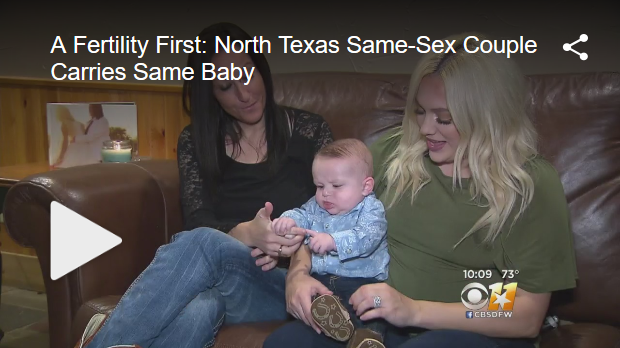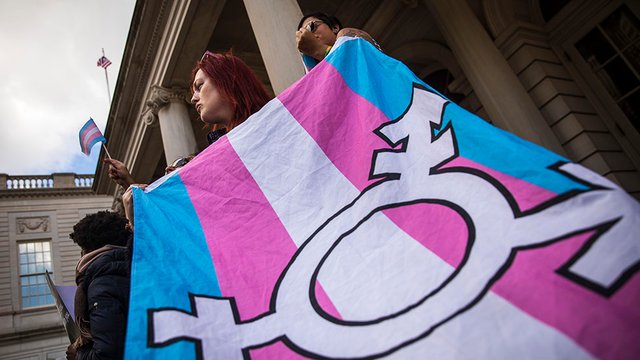In a first, same-sex couple carries the same baby
DALLAS — A same-sex couple in North Texas both wanted to carry their baby. They were able to through a special type of in vitro fertilization, CBS DFW reports.
Now, Ashleigh and Bliss Coulter call 5-month-old Stetson their miracle baby. “The way that Mr. Stetson came into this world was pretty special,” Ashleigh said.
Ashleigh and Bliss knew they wanted kids when they married. They both carried their son through what’s called “Effortless IVF.”
“We gave it a try and it was very, very successful,” Bliss said.
“This represents the first time that two women have both physically carried their child together,” said fertility specialist Dr. Kathy Doody of The Center for Assisted Reproduction.
Kathy and her husband, Dr. Kevin Doody, made it happen using Bliss’ eggs and sperm from a donor.
“She was so confident when she was saying that they can do it,” Ashleigh said. “I think that was surprising to us but also exciting.”
Through Effortless IVF, instead of placing the sperm and eggs into incubators, they go into an INVOcell. The device is then placed in the body for five days where the egg fertilizes and early embryo development begins.
In the Coulters’ case, after five days, Bliss had the INVOcell removed. The embryos were frozen and then one was transferred to Ashleigh. She carried their baby to term.
“This is a revolutionary type of IVF,” Kevin said. “It’s more accessible, it’s more affordable and it’s truly more natural.”
He said it’s received mixed feelings from the medical community.
“I think many have been excited about the thought, but Kevin is correct. Doctors in general, we don’t like change, so I think that their ability to share their story is phenomenal,” Kathy said.
Ashleigh and Bliss said they feel blessed to be able to share the experience together, and more children are in their future.
“You know your whole life changes obviously with anybody when they have a baby so leaning on your partner I think is really, really important and I definitely think it brought us closer together,” Ashleigh said.
Even though the Coulters were the Doodys first same-sex couple to go through Effortless IVF, they’ve performed the process for around 200 heterosexual couples.
They said the process typically costs about half as much as traditional IVF.
Coca-Cola cannabis-infused drink? CEO addresses rumors
Coca-Cola CEO James Quincey on Tuesday dismissed rumors that the beverage giant is mulling an entrance into the legal cannabis industry, even as other beverage brands have explored cannabidiol (CBD)-infused drinks.
“We don’t have any plans at this stage to get into the space,” Quincey told analysts during an earnings call. “So that’s kind of where we are.”
Demand for products containing CBD, a non-psychoactive compound in marijuana, has grown in recent years amid pushes in various jurisdictions to legalize pot. CBD product sales are expected to surpass $1 billion in 2018, according to the Hemp Business Journal.
Bloomberg reported last September that Coca-Cola was in talks with Aurora Cannabis, a Canada-based marijuana company, to develop a CBD-infused beverage. At the time, Coca-Cola said it was “closely watching the growth of non-psychoactive CBD as an ingredient in functional wellness beverage around the world,” but said “no decisions” were made on whether to partner with Aurora.
Constellation Brands, the parent company of Corona beer, invested an additional $3.8 billion in Canopy Growth, another Canada-based pot manufacturer, while Molson Coors Brewing is developing cannabis-infused drinks in the country, Bloomberg reported. Canada legalized pot on the national level earlier this month.
Coca-Cola has sought to diversify its product offerings in recent months in order to boost sales. The company took a major stake in premium sports drink brand BodyArmor last August and agreed to buy U.K.-based Costa Coffee days later.
Coca-Cola topped quarterly sales and earnings estimates in its report on Tuesday, fueled in part by a turnaround in diet beverage sales.
Article via FoxBusiness
A Common Blood Pressure Drug Has Been Linked To Lung Cancer – Here’s What You Should Know
In a new study, researchers from the UK and Canada provide more evidence linking a commonly prescribed class of blood pressure medication to an elevated risk in lung cancer. But is the data strong enough to make us reconsider their use?
Angiotensin-converting enzyme inhibitors (ACEIs) are given to millions of people worldwide to treat a variety of vascular conditions, including hypertension (high blood pressure), coronary artery disease, heart failure, diabetes, chronic kidney diseases, and migraines. Highly effective and often free of any noticeable side effects, ACEIs have become a lifeline in the era of rampant heart disease and diabetes.
Several recent studies have confirmed that short-term regimens of ACEIs are safe, but data on the long-term impacts are less clear. Some investigations following ACEI users have found higher than normal rates of multiple types of cancer, whereas others have found no additional risk. These conflicting results have caused debate within the medical community. One group argues that the cancer risk statistics could merely be the result of other health and lifestyle factors, as is known to happen in retrospective studies. The other claims they are valid and point to a handful of biological studies that have revealed ACEIs can cause an accumulation of cancer-associated inflammatory molecules in the lungs.
Hoping to re-evaluate the cancer risk, the researchers examined health record information from the UK Clinical Practice Research Database (CPRD). They selected 992,061 patients who began a new blood pressure medication regimen between 1995 and 2015, following them until the study endpoint in December 2016, or until a diagnosis of cancer or death.
After adjusting their calculations for a number of factors, the team found that, overall, people who took ACEIs had a 14 percent greater risk of lung cancer compared to those who took angiotensin receptor blockers – drugs that have a similar effect on the body but work by a different mechanism.
However, their analysis also showed that people who took ACEIs for less than five years did not have an increased risk. Those with five to 10 years of use had a 22 percent greater risk, and those with ten or more years of consistent use carried a 31 percent elevated risk. The results have been published in the British Medical Journal.
“Although the magnitudes of the observed associations are modest, ACEIs are one of the most widely prescribed drug classes; in the UK, 70.1 million antihypertensives are dispensed each year, of which approximately 32% are ACEIs,” the authors wrote. “Thus, small relative effects could translate into large absolute numbers of patients at risk for lung cancer. Given the potential impact of our findings, they need to be replicated in other settings, particularly among patients exposed for longer durations.”
But making matters more complicated, other medical researchers are claiming that the study may be plagued by the very same correlation-not-causation issues that the authors were trying to minimize. Speaking to the Science Media Centre, Stephen Evans, a professor of pharmacoepidemiology at the London School of Hygiene & Tropical Medicine, said:
“[This study] has a number of weaknesses, which make it quite likely that the observed association is not a causal one. This is mainly because of inadequacies in the underlying data, and a possible weakness in the analysis.”
Evans notes that one major limitation stems from the fact that CPRD contains poorly recording smoking data that does not distinguish heavy from light smoking. Heavy smoking is tied to a 20-fold increase in lung cancer risk. Additionally, “ACEIs almost certainly prevent deaths from heart disease and that means that especially after long follow-up, the cohort of ACEI users may contain those at higher risk of lung cancer.”
“Drawing strong conclusions and talking about public health impact in this situation seems premature.”
Article via IFLScience!
Transgender fight could prove major test for Supreme Court
The fight over civil rights protections for transgender people could prove to be a major test for the Supreme Court, particularly its conservative wing, as justices weigh whether to take up the issue this term.
The court has a request before it to hear a case challenging whether civil rights laws that prohibit discrimination on the basis of sex in employment extend to transgender workers.
It’s a dispute that may have a significant impact on the Trump administration’s reported plans to exclude federal protections for transgender people by narrowly defining gender.
The New York Time reported last week that the Department of Health and Human Services (HHS) is leading an effort to write a rule that defines gender as a biological, immutable condition determined by genitalia at birth, a move that would affect civil rights laws banning gender discrimination in education programs that receive federal funding.
While the pending case before the justices deals with civil rights in the workplace, experts say a Supreme Court ruling could very well affect the administration’s planned gender rule.
“If the Supreme Court took it and held what the majority of courts are holding — that sex discrimination includes transgender people — the administration would be hard pressed to go ahead with that rule,” said Diana Flynn, litigation director at Lambda Legal, a group that advocates for LGBT rights.
Several federal statutes prohibit sex discrimination in employment, education and health care, and legal analysts say each one has the same underlying language and concept.
“Courts tend very strongly to read them together,” said Harper Jean Tobin, director of policy at the National Center for Transgender Equality. “A ruling under one law would be very likely to impact other laws.”
The case pending before the Supreme Court centers on Aimee Stephens, a transgender woman who alleges she was fired from her job as a funeral director and embalmer after she told her employer she would begin living and working openly as a woman.
Ruling in her favor, the 6th Circuit Court of Appeals said discrimination against employees, either because of their failure to conform to sex stereotypes or their transgender and transitioning status, is illegal under Title VII — the law that bans discrimination based on sex in employment.
The American Civil Liberties Union, which is representing Stephens, says there’s no need for the Supreme Court to take the case because the majority of courts have issued rulings in line with the 6th Circuit.
“The Seventh, Ninth, and Eleventh Circuits agree with the Sixth Circuit’s alternative holding for respondents that when a decision maker discriminates against someone for being transgender, that discrimination is inherently based on sex,” the ACLU argued in its brief.
If the justices decide to weigh in, it could challenge the ideals of conservatives on the bench like Justice Neil Gorsuch, a Trump appointee who prides himself on basing his decisions on the text of the law.
Transgender advocates say you can’t discriminate against someone who is transgender without thinking about their sex.
“I think it would hypocritical in the extreme for justices, who claim to be texturalists, to rule against Aimee Stephens,” said Tobin.
Alliance Defending Freedom (ADF), which is representing the funeral home in its appeal, disagrees.
“The claim rests on a faulty premise,” said Jim Campbell, a senior counsel at ADF. “Title VII does not define sex and should be given its understanding of when it was defined in 1964.”
Back then, he said, sex referred to male or female based on biology and physiology.
ADF’s argument relies heavily on a 2007 ruling from the 10th Circuit Court of Appeals, which said discrimination on the basis of transgender status is not a violation of Title VII.
The Department of Justice Department (DOJ) also argued in a brief last week that Title VII does not apply to discrimination against an individual based on his or her gender identity. DOJ said justices should first take up two other pending cases challenging whether anti-discrimination protections in Title VII extend to sexual orientation.
Transgender advocates say Stephens should prevail even if the justices take the case because the 6th Circuit ruled that the funeral home discriminated against Stephens based on a sex stereotype.
“Circuit courts have uniformly agreed that all people, including those who are transgender, may bring sex discrimination claims under Title VII if their employers discriminate against them because of sex stereotypes related to behavior and appearance,” ACLU argued.
There’s no guarantee the justices will agree to hear the dispute. Court watchers have said the justices may try to avoid weighing politically charged issues after the highly partisan confirmation fight over Justice Brett Kavanaugh.
Chief Justice John Roberts stressed the importance of an independent judiciary in a speech earlier this month at the University of Minnesota Law School.
“Now the court has from time to time erred and erred greatly, but when it has it has been because the court yielded to political pressure,” he said.
ADF’s Campbell said Dec. 3 is the earliest the justices could announce a decision on whether to take up the Stephens case.
As for an administration rule narrowly defining sex, that could take several months at a minimum.
Under the federal rulemaking process, HHS would have to propose a rule, accept and review public comments and then issue a final regulation.
While advocacy groups like the Transgender Law Center have vowed to fight any rule that attempts to remove legal protections for transgender people, they will have to wait for a finalized rule before taking legal action.
Article via TheHill
Kanye West’s Baby’s Modeling Debut With Kim Kardashian Gets Backlash
The baby’s first commercial shoot is being criticized.
The baby’s modeling debut came quite early as she was born only 9 months ago. Her first professional shoot took place in the arms of her mother as Kardashian sports the social media star’s new eyeshadows. The baby’s look is apparently 100% natural which is appropriate given her age.
Kim Kardashian’s KKW Body Campaign With Cellulite & Stretch Marks Is A Total Departure
Months after coming under fire for harmful comments appearing to promote eating disorders, Kim Kardashian seems to be shifting the narrative with her latest Instagram posts, and TBH, it’s about time. Compared to her ads from past years, Kim Kardashian’s KKW Body Campaign with cellulite, stretch marks, and bodies of all shapes and sizes is a total departure. The reality star, who’s no stranger to controversy surrounding the various tone-deaf and damaging body comments she’s made over the past couple of years, appears to be taking a step in the right direction with her latest campaign, and it’s so refreshing.
On Friday, Oct. 26, Kardashian West decided to surprise her fans by posting to her KKW fragrance Instagram channel for the first time in months. Rather than showing off her own nude physique, which is all over the Body fragrance’s Instagram account (the perfume bottle is actually a mold of her naked body, after all), the Keeping Up with the Kardashians personality shared three different photos that seem to be a stab at promoting body diversity and inclusivity.
Simply captioned with the hashtag #KKWBody, the un-retouched images on the KKW fragrance IG and Kardashian West’s official Twitter account feature curves, cellulite, and stretch marks. Fans are flooding to the comments section with messages of support, with some users writing, “Really bodies well done KK!!!” and “This makes me so happy. I could never pose like this, I’m extremely self conscious [sic], but this is absolutely wonderful.”



While the response has been mostly positive, a few users have pointed out that Kardashian’s track record isn’t the best when it comes to body positivity, and a few posts don’t suddenly make her a role model for the movement. The mom-of-three has made a few missteps in the past year, first promoting the sale of appetite-suppressing lollipops, sharing a “fat loss” post on her app, and then, most recently, appearing to bask in comments from her sisters about her looking “anorexic.” Elite Daily reached out to Kardashian West’s team for comment on the backlash, but did not hear back at the time of publication.
In an Instagram Story video shared to Kim’s account back in July, Kendall could be heard telling her older sister, “No, like I’m really concerned. I don’t think you’re eating. You look so skinny.”
Appearing to bask in her sisters’ comments about her looking “anorexic,” Kim responded with the most uncomfortable comment. “You guys! I’m not that skinny!” she said. “I’m down to 119 pounds.” Elite Daily reached out to Kim, Khloé, and Kendall’s teams for comment at the time of the post, but did not hear back at the time of publication.
Article via EliteDaily
A New Hotline for racist white people
Although this is satire and there’s truth in it the number really does work and if you’re a racist or even an Uncle Tom looking at this post and get up in your feelings every time Ti tells the TRUTH this is the number for you ! Hotline available 24 hours a day seven days a week Call 1-844-WYT-FEAR that’s 1-844-998-3327
CDC Says It’s Concerned About Polio-Like ‘Mystery Illness’ That’s Paralyzing Kids
The Centers for Disease Control and Prevention this week issued a warning about a disease known as acute flaccid myelitis (AFM), an illness it says it knows very little about but can cause arm or leg weakness and paralysis, particularly in children. According to a Tuesday press briefing, there have been 62 confirmed cases across 22 states in 2018.
AFM is an extremely rare but serious disease that affects the nervous system and results in polio-like symptoms, though the CDC says that all confirmed cases of AFM have tested negative for poliovirus. One death of a child diagnosed with AFM occurred in 2017.
“While we know that these can cause AFM, we have not been able to find a cause for the majority of these AFM cases,” Nancy Messonnier, director of the National Center for Immunization and Respiratory Diseases, said during the media teleconference. “The reason why we don’t know about AFM—and I am frustrated that despite all of our efforts we haven’t been able to identify the cause of this mystery illness—we continue to investigate to better understand the clinical picture of AFM cases, risk factors and possible causes of the increase in cases.”
“Despite extensive laboratory testing, we have not determined what pathogen or immune response caused the arm or leg weakness and paralysis in most patients,” Messonnier added.
Messonnier said that the CDC has neither a clear idea of who might be at higher risk of developing the disease nor why. Additionally, it doesn’t know what long-term effects of the illness could look like. Ninety percent of children diagnosed with AFM are under 18, with the average age of children in confirmed cases being about 4.
The CDC began tracking the illness in 2014 and has seen a spike in reports in August and September every 2 years, according to data on its website. It has received 127 reports of patients under investigation (PUIs) for AFM this year, though it notes that figure includes the 62 confirmed cases. The CDC received reports of 33 confirmed cases of AFM across 16 states in 2017, down from 149 confirmed cases in 39 states in 2016. In total, there have been 386 confirmed cases since 2014.
Despite the recent spike in reported cases of AFM, Messonnier underscored that the disease is “incredibly rare” and has been diagnosed annually at a rate of less than one in a million since 2014.
“Parents need to know that AFM is very rare, even with the increase in cases that we are seeing now,” Messonnier said. “We recommend seeking medical care right away if you or your child develop sudden weakness of the arms or legs. As we work to better understand what is causing AFM, parents can help protect their children from serious diseases by following prevention steps like washing their hands, staying up to date on recommended immunizations and using insect repellent.”
Article via Gizmodo
Pope compares having an abortion to ‘hiring a hit man’
VATICAN CITY (Reuters) – Pope Francis on Wednesday compared having an abortion to “hiring a “hit man” to eliminate a problematic person, in comments sure to be welcomed by conservative Catholics who have accused the pontiff of not speaking out enough on “cultural war” issues.
Abortion is a raging political battle in a number of countries, including the United States, where many conservatives hope the Supreme Court will eventually overturn the landmark 1973 ruling known as Roe v. Wade, which legalized abortion.
Francis made his off-the-cuff comments on abortion, some of his toughest to date, in an address to tens of thousands of people gathered in St. Peter’s Square for his weekly general audience.
The pope denounced what he called the contradiction of allowing “the suppression of human life in the mother’s womb in the name of safeguarding other rights”.
“But how can an act that suppresses an innocent and helpless life that is germinating be therapeutic, civilized or even simply human?” he said.
“I ask you: ‘Is it right to ‘take out’ a human life to solve a problem? What do you think? Is it right? Is it right or not?” he said in unprepared remarks.
Many in the crowd shouted “No”.
“Is it right to hire a hit man to solve a problem? You cannot, it is not right to kill a human being, regardless of how small it is, to solve a problem. It is like hiring a hit man to solve a problem,” he said.
The Roman Catholic Church teaches that life begins at the moment of conception and ends at the moment of natural death. It also forbids euthanasia but says that a family or a patient can decide to stop using extraordinary means to keep people alive.
Shortly after becoming pope in March 2013, Francis appeared to downplay the importance of “cultural war” issues such as abortion, contraception and gay marriage, saying in an interview the Church had become “obsessed” with them.
“It is not necessary to talk about these issues all the time,” he said in that interview, adding that the Church’s stand on them was very clear and that it also had to address social issues such as poverty, injustice and immigration.
Article via Reuters











